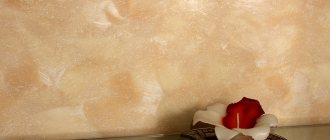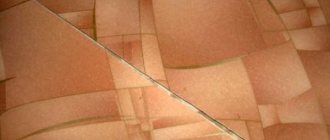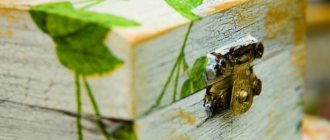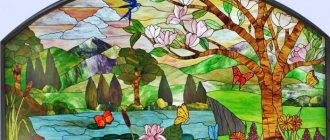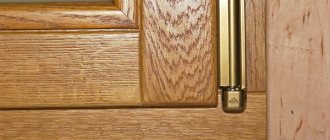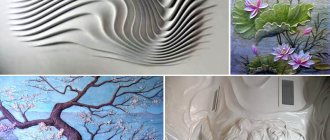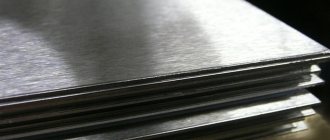Slate is gradually being forced out of the market and this is due, first of all, to the advent of more modern roofing materials with high decorative qualities. Naturally, a house covered with bright material looks much more advantageous than one decorated with gray slate. But slate is a fairly good quality material that can compete with alternative options.
To make a slate roof look more modern and lively, it can be painted in the desired color. But at the same time, you need to take into account the type of paint and the technology for its application, since painting work requires full compliance with all the rules. This article will answer the question: “How to paint slate?” and will give practical advice on doing this work yourself.
Slate coloring technology
The choice of paint and its color is a responsible process. But, unfortunately, even the most expensive and high-quality enamel cannot guarantee a reliable decorative and protective coating on slate. If you do not follow the painting technology, then the pigmented film will almost certainly behave unpredictably. For example, it will begin to crack, swell or crumble much earlier than the end of its service life (possibly even a few days after painting). Therefore, you also need to know how to paint slate correctly!
The process of painting slate is carried out in several stages:
The slate surface to be painted must be cleaned of dust, dirt, fungal and plant deposits, and unstable (or incompatible with the chosen paint) coatings.
Cleaning can be done in two ways: dry mechanical (manual or mechanized) and using pressurized water jets. Sometimes these methods are combined and performed alternately.
For manual mechanical cleaning, wire brushes are used to scrape off efflorescence, dirt, moss and lichens. The work requires considerable effort and accuracy, and the cleaning speed is very low. You can clean slate faster and better with the help of tools. To do this, put an attachment on a grinder or drill, which is essentially the same brush for metal. When the tool is turned on, it begins to rotate, cleaning off surface defects of the slate.
The second cleaning method is to wash the slate with high-pressure water jets, which are created by car mini-washes (Wagner, Karcher, etc.). In this case, the created pressure should be within 100-250 atmospheres. Mini washers that release water at a lower pressure will not be able to remove contaminants, while higher pressure mechanisms will destroy not only the defects, but also the slate itself.
To impregnate the top layer of slate, special compounds are used - primers. They are selected in accordance with the instructions for using the specific coloring composition. For example, organosilicon paint Ko-slate is combined with silicone primer KO-011S. However, organosilicon paints, as well as “Liquid Plastic” compositions and alkyd enamels can be applied without prior priming. Acrylic paints, on the contrary, require the use of a primer. These can be either special compositions (for example, Dupa-grund for Alpina DACHFARBE) or paint diluted according to the instructions. To obtain an impregnating primer for Alpina DACHFARBE acrylic paint, it is enough to dilute it with water to 10% of the volume.
The primer is applied to the slate in 1-2 layers using a brush, roller or spray gun.
Direct painting is done over the dried primer. As a rule, it is enough to apply 2 layers of paint, the first of which will be the base, and the second – the finishing. The base layer is the main one; it must carefully cover the entire surface of the asbestos cement, including the ends, corners, joints, ridge and corner parts. After the first layer has dried, paint it again. The task of the second (finishing) layer is to ensure that the painted slate receives a bright, uniform color, without streaks.
Treatment is carried out with a brush, roller or spray.
This simple technology will give slate color and high decorativeness, comparable to the beauty of tiles, bitumen or metal roofing. In addition, painting (with periodic renewal of paint) will provide reliable protection for the roof from environmental influences and will increase its service life for decades.
Preparatory work
At the very initial stage of renovation, the outer surface of the slate must be carefully inspected to identify all problem areas. It is necessary to check all the fasteners that hold the sheets, and also diagnose the joining points. Typically, it is in these small grooves that unwanted foreign particles (dirt, leaves, etc.) accumulate.
The “ridge” requires special attention, as well as the outlet of the chimney and ventilation, if the pipes pass through the roof. All existing cracks can be sealed with liquid plastic; after drying, it will harden and prevent moisture from entering.
After studying and identifying all the shortcomings, it is imperative to eliminate them. Fastening screws that have play or if they do not have rubber seals on the head, they must be replaced, this will prevent water from entering the attic of the house.
The next stage of preparation is a thorough cleaning of the roof. As already noted, in the case when the slate has been lying for a long time, vegetation can even form on it. First you need to clean it with a metal brush or grinder with a special attachment, and then rinse the entire surface with water.
A Karcher mini car wash is ideal for this purpose. It has excellent water pressure. With its help, you can very quickly and efficiently remove all unwanted particles of dirt, leaves, fungal growths, moss, etc. When working to wash away dirt and asbestos dust after grinding, you cannot use the maximum pressure; the recommended pressure value is 200 atmospheres. If you carelessly allow a strong pinpoint impact of water, you can easily break a sheet of slate.
The sprayer should be sprayed at a slight angle to avoid unexpected damage.
After complete drying, the next two stages of surface preparation begin, namely:
- antiseptic treatment . A special composition, harmless to humans, completely destroys fungus, mold and prevents the possible occurrence of aggressive influences in the future;
applying primer . The liquid, viscous mass of deep penetration is impregnated into all irregularities and cracks, thereby creating ideal conditions for final painting of slate. The plane becomes smooth, and paint consumption is ultimately significantly reduced.
The primer and antiseptic are applied to the surface with a roller or brush. When working on the roof, you need to avoid putting pressure with your own weight on places where the slate is not secured, it will simply break. For these purposes, it is necessary to use a ladder, the upper part of which is securely attached to the ridge, thus redistributing the load over the entire plane. These precautions must be followed throughout the repair process.
All preparatory work is of great importance. Only their careful implementation ensures high-quality painting of slate and reduces material consumption.
There are two methods of painting: spray or roller and brushes. The first option is the most preferable, since the work is done quickly and efficiently. The paint layer is applied evenly to the surface, and the jet, supplied under pressure, reaches all hard-to-reach places.
If you don’t have a spray gun at hand, you can get by with a handy entrenching tool, but you need to prepare yourself for long and labor-intensive work in very extreme conditions. First you will need to use a brush, you need to go through all the places where you cannot reach with a roller. Next you need to roll out the paint with a foam nozzle.
When thinking through a design project, it is worth thinking about the color of the roof and its combination with ebbs, ridge and drainage elements running along the perimeter of the house. The appearance acquires individuality and completeness when the accessories are different in color from the roof, and do not merge into one monotonous picture.
You need to keep in mind that using the second method, according to technology, you will have to apply two layers of paint, and sometimes 3-4. In the case of a spray gun, you can limit yourself to two, but the consumption will still be less. It is more expedient and more economical to rent a professional tool if one is not available.
Paint can be applied using a brush
No. 3. Types of paints for slate
Great, we've sorted out the material.
Now is the time to move on to how to choose paint for slate, what to look for and what to consider before purchasing? By and large, nothing complicated awaits you in this process, since the main things you will have to focus on are the type of paint, depending on the main active ingredient, as well as the manufacturer. It is these two components that are decisive, and therefore we will dwell on them in more detail.
So, first of all, as we have already found out, slate paints differ in the main active ingredient and are divided into four types:
Acrylic. Also known as water-based paints, they are widely used and are often used for painting slate. Mainly also because they endow it with positive properties, such as increasing the sliding characteristics of the surface. The latter, for example, is extremely practical in the situation with precipitation in general, since it flows off the roof much more easily without lingering there and without having a negative impact. Such protection from moisture simultaneously protects the slate from destruction, significantly extending its service life. The color palette of acrylic paints is varied, and you will surely find an option that suits you and your home. They also dry quite quickly.
Enamel. One of the best options for increasing the strength of slate and giving it reliable protection from atmospheric influences are paints of this type. One of the advantages of enamel paints is the formation of a coating that is similar in appearance to enamel, which is characterized by additional durability. If you don't want to repaint your slate for a fresh color anytime soon (which can vary depending on a variety of factors), then enamel paint is a great option because it contains pigments that protect it from fading.
Liquid plastic. In most cases, they are synthetic paints based on various polymers or bitumen, although some also claim that liquid plastic refers to acrylic construction paints. One way or another, these are modern paints, the advantages of which are good adhesion to the slate surface, durability and reliability. Another advantage is that they are quite affordable, but they also have disadvantages. Since these are synthetics, the composition of such paints is often replete with substances harmful to health, and moisture protection, in comparison with acrylic paints, may not be as reliable.
Rubber. The last type of paint, which is considered the most popular for use when painting slate, as it has a large number of advantages, eliminating the disadvantages of the previous types. Here you also have high elasticity, which allows the paint to stretch without damage, which is especially practical when microcracks appear on slate. However, it will take a lot of time before they appear, since rubber-based paints protect it well from all kinds of irritants. Separately, it is worth noting that it does not contain substances harmful to human health, and also has high fire safety and does not succumb to combustion.
Of course, to improve the performance characteristics of slate, many recommend using rubber paints, applying them in at least two layers. However, the final choice will still depend on your needs and budget. So, taking into account all the information received above, you can certainly choose the most suitable option for you without much difficulty.
Technology of applying paint to slate
Despite the apparent simplicity of applying paint to slate, the process must be carried out correctly. The technology consists of three stages.
Stage No. 1 – preparatory
Here the slate surface is prepared. It just needs to be cleared of everything unnecessary. To do this, they use two methods: mechanical and hydraulic.
- To do this, use brooms, wire brushes or an electric tool on which special wire brushes in the form of disks are mounted. The mechanical option is a labor-intensive and time-consuming process, especially if the slate is overgrown with moss and lichen. Vegetation will also have to be removed with scrapers.
- This method is simpler because water under high pressure is used as a tool. To do this, you will have to purchase a pump, a long hose and a nozzle. The main task is to provide the process with a large volume of water.
Sometimes a combination of two methods is used if the roof covering is completely dirty.
Stage No. 2 – primer
As mentioned above, not all paints require a slate roof to be primed. But if this is required, then the choice of primer coating is based on the manufacturer’s recommendations. In addition, many companies that produce paints and varnishes for slate also offer appropriate primers.
The method of applying primer is brushes, rollers or sprays. Apply the material in two layers. The second one must be done after the first one has dried.
Stage No. 3 – painting slate
This process is no different from the previous one in terms of application. The paint is applied in two layers: the first is the base, the second is the finish. The base is applied in a thick layer. It should cover all visible defects of the slate roof: small cracks, pores and chips. The finishing coat covers the roofing deck with a uniform, thin layer, covering the smudges of the base layer and giving it a bright, rich color.
How to paint slate
First of all, let’s figure out how to paint the slate on the roof. You can often hear that painting slate and other asbestos-cement materials is extremely short-lived. Skeptics claim that the paint layer begins to crumble after the first winter, so it is better not to bother with this procedure at all.
In fact, everything depends on the choice of paintwork and compliance with technological requirements. Even a wooden door, if it is not painted correctly, will lose its attractiveness in a year.
Slate paint Triora
Today, deciding what to paint a slate roof with is not difficult. Special coloring compositions for coating asbestos-cement materials are produced by both foreign and domestic manufacturers. They are made on a silicone or acrylic base, which ensures high reliability of the coating.
Among the most common paint coatings on the market for these purposes, the following brands can be distinguished:
Triora is a domestic slate paint made on an acrylic base. This composition has excellent performance properties, including moisture resistance and light fastness. The paint is applied to the primed surface in two layers.
Initially, the composition is white, however, with the help of tints, you can give the coating almost any color and shade. Another advantage of this paint is its low price.
- KO-slate - this composition includes a mixture of silicone-based dyes and fillers. It has good adhesion, excellent decorative properties and resistance to mechanical stress.
- Kilpi from Tikkurila is a slate roof paint made with an acrylate modified dispersion. This is quite an expensive coating, but the high cost is justified by the high quality. The coating does not lose its elasticity even at very low ambient temperatures.
When choosing paint, keep in mind that they differ not only in properties and composition, but also in consumption. Therefore, low cost does not mean savings.
Slate paint – Kilpi
It must be said that all these types of paints are intended for application exclusively to asbestos-cement surfaces.
However, there are often all kinds of metal structures on the roof, these are:
- Roof ridges;
- Visors;
- Chimneys;
- Fencing, etc.
Therefore, in addition to paint for slate, you should prepare compositions for metal surfaces in advance. For example, fire-retardant metal paints Polistil are suitable for chimneys.
Paint for metal surfaces – Zinga
Zinga electrically conductive paint can protect skates and other metal elements from corrosion. Moreover, it provides not only passive (barrier) protection, like ordinary paint, but also active (cathodic) protection.
Generalization by type
As you can see, there is a considerable assortment. There is plenty to choose from. But it is necessary to point out that each variety has its own price, which plays an important role when choosing. This is especially important when you need to paint slate on a large roof area. An expensive option will lead to an increase in the budget allocated for painting.
This is also important to know: Slate roof - do-it-yourself covering
But, as practice shows, such a choice is a coin with two different sides. Expensive paints such as silicone or polymer make it possible not to repair the coating for 15 years. In this case, the applied paint layer burns out slowly, practically without changing the original color. But the cost of the material is two to three times higher than the same alkyd ones. Therefore, the consumer, when purchasing slate paint, must take this point into account. That is, buy a cheap option, but repaint it after 5 years. Or give preference to an expensive coating.
The most popular paint brands
The market for paints for construction purposes is replete with brand names from the most famous manufacturers. However, which one is best for staining slate? Today, the following manufacturers are in high demand:
- Dahbeshikhtund. Paint from a German campaign, characterized by excellent performance properties. Of course, its cost is much higher than its domestic counterparts, but its quality makes it a leader. It has high adhesive properties, good strength, and long-term operation. It is recommended to use it for natural type tiles and slate.
- Polyfarb. A Polish-made product made on a dispersion basis. One of the features is the ability to dry quickly, which significantly speeds up the work process. Also, thanks to coloring, resistance to moisture and ultraviolet radiation increases.
- Aqua. The creators of the paint are the joint work of Finland and Sweden. It dissolves easily in water. A distinctive feature is resistance to alkaline environments. In practice, Aqua is used not only for painting slate surfaces, but also for concrete bases.
What paint and primer is best to paint the roof of a house?
Before you start painting the slate surface with your own hands, it must be impregnated with a special composition that prevents the development of pathogenic microflora. Apply it with a wide brush, paint roller or spray. To ensure high-quality protection, antiseptic treatment is performed in several layers.
There are special primers for slate
Then a composition is applied to the coating that prevents the penetration of moisture. Due to the porous structure of slate, its premature destruction occurs precisely from the aggressive effects of water. After antiseptic and moisture-repellent treatment, a layer of primer is applied. It provides high-quality adhesion of the paint to the base and reduces its consumption. The primer should be purchased from the company that produced the main paint material, and it should contain components that prevent the development of pathogenic microflora.
The paint and varnish material used for painting must be well resistant to aggressive environmental influences, heating by direct sunlight, and have water-repellent properties. Acrylic and alkyd paints, polymer and silicone based coatings have these qualities. We'll figure it out a little later which one is better.
Painting is performed in two layers, the first of which is the main one. You can apply the paint with a paint roller, a wide brush or a spray gun. Of course, painting the slate surface is carried out in dry, windless weather.
Acrylic paints
The most widely used are water-soluble acrylic compositions. They do not emit a strong odor or toxic substances due to their water base, do not ignite when exposed to an open flame, do not require the use of solvents and form a waterproof coating with a service life of about five years. Acrylic paint applied to the surface dries within sixty minutes. The disadvantage is that it has a liquid consistency and streaks may form on the coating.
How to paint slate with your own hands - step-by-step diagram
Step 1: Check the surface
For high-quality painting, it is necessary to carefully prepare the slate surface. This process is carried out in several stages. If this is an old coating that has been in use for many years, then you should start with a “meticulous” inspection
Pay special attention to the coating - you may find moss on it. It will need to be removed before painting.
Step 2: Prepare the area for work
Some experts recommend clearing vegetation from your roof using a drill and brush. The main thing with this approach is not to accidentally damage the sheets themselves. Once you have dealt with the moss, you need to check if there are any breaks or cracks on your roof. If they do exist, we seal them with a mixture that can be made from PVA (diluted with water), cement and asbestos. We have resolved the issue with cracks and defects - we begin to remove debris and dust. Only an absolutely clean surface will allow you to achieve the desired result when painting.
Step 3: Wash the coating surface
In order to wash the slate surface, we use household brushes and water. Just do not forget that after such water procedures the slate must dry thoroughly. Don’t try to do everything quickly and “just how.” Better slowly, but efficiently!
Step 4: Working with Primer
Further work with the coating involves a primer. We treat the slate coating with a special compound in order to increase the “adhesion” of the materials. This process will also help to achieve the necessary contact between the slate paint and the top coat. By the way, asbestos cement roofing absorbs any materials quite well, and if you treat the surface poorly, you risk encountering stains after painting that will stand out strongly.
Step 5: Paint the roof
If you do everything correctly, then it is better to start painting in cloudy rather than sunny weather, and the air temperature should be about plus 15 degrees. At temperatures above 35 and below 0, you will simply face the impossibility of your mission. However, some manufacturers assure that their brainchild can be used at fairly low temperatures.
There are two methods of applying paint - manually or using a sprayer. You have the right to choose as you wish. Either one or the second option will be effective. Just keep in mind that the paint consumption indicated by the manufacturer often does not correspond to reality. So, you have applied the first layer - now you need to let it dry thoroughly. Your paint package will indicate how long to wait before applying the second coat. But keep in mind that it is better to give the roof more time than indicated by the manufacturer (optimal conditions are indicated on the container).
Step 6: Finish painting
If you have used a high-quality primer, then a second coat will be enough to get an even color and coverage. If you still have doubts or the result does not satisfy you, it is better to resort to a third attempt. The final layer is considered to be the one after which you get a uniform color coating. And do not forget that the paint will completely harden only after a few days.
Dyes
What coloring agents do we have to choose from?
Tinting impregnation
Our first object for research is impregnation paint for slate, produced by St. Petersburg LLC Mendeleev. The composition is intended for:
- decorative painting;
- antiseptic protection of porous mineral surfaces used in open air conditions.
In addition: the manufacturer emphasizes that impregnation stops the dusting of slate with asbestos fiber, which is hazardous to health. The argument is rather dubious: any coating has this property.
Here is the information from the manufacturer's website:
| Parameter | Meaning |
| Application | Two layers without preliminary primer 0.12 – 0.15 mm thick |
| Compound | Pigment, alkyd-phenolic and styrene-acrylic resins, antiseptic additives, organic solvent |
| Diluent | “Turbo-jet” produced by Mendeleev LLC |
| Dry residue | 30% |
| Consumption per layer | 200 – 330 g/m2 |
| Application temperature | +5 – +30С |
| Drying one layer | 2 hours |
| Price for 1 kg | 250 rubles |
Impregnation produced in St. Petersburg based on organic solvents and synthetic resins.
Acrylic
This category of dyes is a dispersion of acrylic resins in water or an organic solvent. As a sample, we will study the paint “Shikril” from the Moscow company KrasKo.
According to the manufacturer, “Shikril” has the following advantages:
- Compatible with any mineral substrates (including CBPB and brick), as well as with roofing felt;
- Resistant to any weather conditions, including snow and ultraviolet radiation;
- It is elastic, which allows it to withstand fluctuations in the linear dimensions of the roof when the outside temperature changes;
- Increases the service life of slate by 1.5 - 2.5 times;
- Again reduces asbestos air pollution.
And now – dry numbers.
| Parameter | Meaning |
| Layer drying time | 1,5 hour |
| Painting temperature | Not lower than -15C |
| Application | 1 – 2 layers over the primer “Shikril-Grunt” |
| Consumption | 250 – 350 g/m2 |
| Basic colors | Carmine, red, green, gray |
| Dry residue | 70% |
| Diluent | Xylene |
| Price for 1 kg | 209 rubles |
“Shikril” from the Moscow company KrasKo.
Silicone
This type of dye uses a dispersion of silicone resins in an organic solvent as a binder. In addition to resin, the composition contains pigments, fillers, antiseptic additives and stabilizers, which allow the coating to withstand ultraviolet irradiation.
Curious: silicone-based paints are also known as silicone paints.
The next object for study will be roofing enamel KO-Slate from the Kyiv plant Constanta. The manufacturer assures that it:
- non-toxic after curing;
- fireproof;
- protects slate roofs from adverse weather conditions;
- reduces the migration of asbestos fibers into the atmosphere.
Simply put, the composition in practical terms is no different from any other roofing paint.
Let's move on to the numbers:
| Parameter | Meaning |
| Mass fraction of dry substances | 85% |
| Consumption when applied in one layer | 150 – 200 g/m2 |
| Application | On a base free of dirt and old coatings. Preliminary priming with silicone primer KO-080 is recommended. |
| Diluent | Solvent, xylene, toluene |
| Price for 1 kg | 41.68 hryvnia (115 rubles at the exchange rate as of 03/04/2016) |
The choice of colors is small - only red and green.
Rubber
So-called rubber paints for slate are water-based emulsions of latex and acrylic resins with the addition of pigments and fillers. After the water evaporates, they form a highly elastic and completely water-impermeable membrane. At the same time, the coating retains vapor permeability (which will prevent the accumulation of moisture in the thickness of the painted material) and boasts considerable wear resistance.
Our next test subject is “Rezel+” paint from the Sevastopol Accent LLC.
| Parameter | Meaning |
| Compatible bases | Slate, chipboard, concrete, wood, varnishes, paints, plastic |
| Color | White (titanium dioxide pigmentation). Can be tinted with any water-soluble pigments |
| Dry residue | 47% |
| Consumption per layer | 150-200 g/m2 |
| Layer drying time | 1 hour |
| Application | 2 – 3 layers on a base free of dirt. Glossy surfaces are pre-polished; absorbent bases are primed with acrylic primer VD-AK-1440 |
| Price for 1 kg | 150 rubles |
Rubber “Rezel+”. Made in Sevastopol.
conclusions
All paints are relatively inexpensive and provide an acceptable level of roof protection. Is it possible to give preference to one type of dye?
The deeply subjective sympathies of the author of these lines are given to rubber paints. Why?
- They are undemanding to the base. The author had the opportunity to use the above-mentioned Rezel+ not only on slate, but also on alkyd enamel, plastic, drywall, OSB and plywood. No damage to the coating was noted after two years of operation;
- Water-based means no odors during application. Organic-based dyes will leave you inhaling toxic fumes for several hours;
- Rubber paint can be applied to a damp base - unlike any compositions based on organic solvents.
Recommendations for painting flat slate
To achieve high-quality painting, it is important to know some features in slate finishing. For this procedure, it is better to choose a cloudy, not hot day: the temperature should not rise above +18 degrees
This will allow the paint to adhere well and dry in an optimal manner. Sometimes some paints indicate the ability to work at zero temperature, but it is better not to take such a risk.
Painting flat slate can be done in several ways. The simplest of them is to use a construction sprayer. As a rule, the instructions for the sprayer contain incorrect information regarding the volume of material consumption per 1 m2: practice shows that it is an order of magnitude higher. After applying the first layer, you need to give enough time for it to dry thoroughly. This time may differ for different formulations: the exact information is indicated on the packaging.
In any case, it is better to make the pause between applying individual paint layers longer than recommended by the instructions. The fact is that if you apply the next layer on top of the previous one that has not completely dried, in the future this may cause peeling of the painted slate. This is due to the fact that the liquid sealed under the new layer does not have the opportunity to evaporate, which is why swelling and peeling occur. As for the deadlines indicated on the packaging, they assume the ideal fulfillment of all conditions, which in practice usually causes problems. Also, one should not discount the usual marketing ploy when a manufacturer slightly overstates the characteristics of its products. Sometimes it is necessary to make holes in slate sheets. Knowing how to drill flat slate, you can do it quickly and easily.
How is flat slate painted at the factory?
You will be interested to know how slate is painted in production. So, the simplest technology is to apply paint to the outside of the sheets. But such slate is just “painted”. If additional surface protection is necessary, then a layer of paint is applied not only at least twice, but also under special conditions: conveyor lines heated to a certain temperature.
Many home craftsmen try to replicate this technology in their own yard: they simply lay flat slate on the grass on a hot sunny day, and it heats up from the rays. Then they paint and admire the resulting beautiful and durable roof. Tricky, isn't it?
Sometimes, of course, a special pigment is added directly to the raw material mixture, and then the slate is produced “colored”. Its advantage is that such slate does not fade at all, and when cut, the edges have the same color as the sheet itself. Even severe scratches will not be noticeable. But such slate costs much more than usual.
That’s why some manufacturers use a combined option: because slate, like plywood, consists of several layers; only the top one is painted. In other words, the top layer is deeply saturated with paint, and not just painted. And it is only 10% more expensive than regular gray.
Painting slate - what, how and why?
Let’s take as a starting point that you will have to personally tidy up the roof of the house, which means that you will have to become thoroughly familiar with such a rather important process as painting slate with your own hands – from “a” to “z”. If the slate on the roof of your house is in good condition, without cracks or damage, durable and does not allow water to pass through even in heavy rain, then you can begin work. But in order to put your roof in order for the next ten years and be confident in the final result of your work, you will still have to make considerable efforts. To do this, you will need to at least check, and if necessary, update the entire roof or part of it.
If your coating is completely leaky, then no amount of painting will help such a roof covered with cracks. Here you need to safely buy new slate, which will be the color you want. We will talk about work that concerns such a process as painting slate on a roof, but for the material that has been in use for more than one year. So, after one decade, or maybe more, your roof doesn’t look very good, and let’s say it’s completely unpresentable. Which means you need to get to work. As experts say, painting old slate is a completely doable job, but it is labor-intensive and not as easy as it seems at first glance. So, you will need, firstly, to find out about the real condition of the roof, and secondly, to decide on paint and varnish materials.
In order to avoid problems in the future, you need to choose the right material. And don’t listen to those who confidently say that after painting such a product, the paint layer will crack and crumble literally after the first cold weather. There are many examples when, after painting (with the right materials), painted slate pleased its owners with its appearance for many years. So we make it a rule to choose paint accurately and comply with technological requirements when working. In addition, you should consider what kind of slate you have - wavy or flat. It depends on what is better to paint - with a paint roller or a brush. If you already use the material (installed on the roof), then you will have to stock up not only with patience, but also with a ladder (preferably very stable, since the work will not take an hour or two). If you are going to paint the product on land, then prepare a special elevation for convenience (so that the product does not crack or get dirty).
What paint is better to paint slate on the roof of a private house with your own hands, advice from craftsmen
There is a huge selection of roofing materials on the modern construction market, but despite this, ordinary gray slate has not lost its popularity.
This is explained by its good performance, resistance to temperature fluctuations in the external environment, long service life and low price. Houses covered with slate in the last century faithfully serve their owners to this day, but the surface of the roof, while maintaining its performance characteristics, has an unsightly appearance. Slate staining helps correct the situation. Painting slate with your own hands is quite possible, you just need to know how to do it correctly.
Perhaps painting slate is an interesting and even enjoyable activity
Slate processing process
After we have cleaned the work surface of excess dirt, we can begin processing the slate itself. This process includes the application of an antiseptic and hydrophobization. Antimicrobial substances will help kill parasites that live in microcracks in the material. Plus, it will prevent them from multiplying and spreading. You can do the treatment with a regular brush, but it will take longer and require a lot of effort. It is best to use a special sprayer. When antiparasitic treatment, be sure to wear gloves on your hands and glasses or a respirator on your face to avoid poisoning.
The slate surface becomes porous over time due to increased humidity, which leads to early damage and destruction. In order to improve the quality of the cover, hydrophobation should be carried out. These measures have a positive effect on the service life of the roof. Painting flat slate or any other type will help restore a neat appearance. It is best to carry out the procedure immediately after laying the material, but many developers do not think about this right away. They consider this option only in situations where the products have already lost their aesthetics. In the next section we will consider in detail this important and final stage of work.
Why paint?
The main disadvantage of slate is the possibility of moss and algae growing on it. Plant activity leads to an increase in pore sizes and the appearance of microcracks, which reduces the operational potential of the roof. The growth of moss also negatively affects the appearance of the roof.
Another disadvantage of slate is its fading over time. The material peels off and the original structure of the coating is destroyed.
Proper painting of a slate roof can eliminate these shortcomings. It will increase its moisture-proof properties and give it a pleasant appearance, prevent the material from peeling off, and the appearance of moss and fungi on it.
Asbestos is considered a carcinogen that is hazardous to health. Asbestos dust constantly emanates from unpainted slate into the atmosphere and poisons it ; painting the material allows you to minimize this process and make the roof more environmentally friendly.
No. 2. Advantages and disadvantages of slate
We have already understood that painting slate generally has a positive effect on its properties. However, since we said that this roofing material has a number of advantages over some analogues, it would not be amiss to list them. And among the main ones it is worth highlighting the following:
- high strength due to the successful combination of asbestos with cement;
- does not rust, does not conduct electricity;
- resists moisture well and does not heat up as much in the sun (like metal);
- can last much longer;
- much more affordable price compared to analogues.
Of course, it also has a number of other positive features, such as good sound insulation or the absence of toxic emissions during combustion, but these are no longer so important features for many consumers. Frankly speaking, slate also has its drawbacks, which are worth mentioning for the sake of objectivity. Fortunately, there are not many of them, and they are expressed in rather heavy weight (one sheet of slate weighs about 18 kg), and also in the fact that despite its high strength, slate can be extremely fragile. It will not be difficult to damage it during careless transportation or installation.
Slate painting
Slate should be painted by applying two layers of paint and always after the primer has completely dried:
- The first layer - the base layer - covers the entire surface of the roof, including corner joints, joints and ridges.
- The second layer - finishing - is applied after the first layer has completely dried. It gives the slate an even, uniform color.
Slate painting
Types of paints for slate
Painting slate with the wrong material is not advisable. The coating will swell and begin to bubble within the first year. Asbestos fibers are not compatible with all types of paints. The following types of products for staining slate are distinguished:
Water-based acrylic paints
Water-dispersion paints are widely used, are easy to use and significantly improve the performance of slate roofing. An extensive range of products with varying degrees of matte finish and a wide range of colors will help you choose a coating to suit every taste. The functions of the solvent here are performed by water.
Distinctive characteristics:
- easy to apply, do not smear, dry quickly;
- fireproof, environmentally friendly, characterized by the absence of a pungent odor;
- create a reliable moisture-proof coating;
- increase resistance to temperature changes;
- no solvent required;
- The service life of acrylic coating is about 5 years.
Water-based acrylic compositions also include paint, which is called “rubber”. The components remain the same, only the structure of the material is very thick and similar to mastic. This composition applied to the roof forms an elastic and very flexible film. This universal material is used not only for painting roofs, but also for covering swimming pools, showers, treadmills, and various anti-slip structures.
Acrylic paints based on organic solvents
A type of acrylic paint, however, not water, but special organic solvents are used as a thinner. I usually use white spirit. This type of coating differs from water-dispersion coating by increased strength, elasticity and higher hydrophobic properties. This paint does not fade for a long time and retains its original color.
However, when painting, it is worth considering that the paint has a pungent odor, which gradually dissipates, and the drying time of one layer is about 12 hours.
Organosilicon (silicone) paints
Silicone paints are a composition of dyes and various additives in a silicone binder. This roof covering is considered one of the most reliable and durable, has increased elasticity and water resistance. The enamel permeates the top layer of the material, actually providing an additional protective coating to the roof, filling cracks up to 0.2 cm. It provides the roof with a deep, long-lasting color that does not fade or fade in the sun.
Properties of silicone paints:
- fire safety, no pungent odor;
- increased strength and elasticity;
- high frost resistance and hydrophobicity;
- dirt-repellent properties, enamel also prevents the proliferation of mosses and lichens in the pores of the material;
- does not require surface priming;
- service life is about 10-15 years.
Alkyd slate paints
Alkyd enamels for slate contain alkyd resins in addition to pigments and additives. This coating has good adhesion to the roofing material and a short drying time (about 1 hour). The paint forms a durable elastic film that is resistant to external influences and cracking. The enamel has increased moisture resistance, frost resistance and protects the slate from contamination. Another positive quality is that it does not require priming the surface before application. The durability of the coating is about 5 years.
Polymer paints “Liquid plastic”
Polymer-based enamel contains components such as polyurethane, vinyl or polystyrene, due to which, after drying, it forms a thin but durable plastic layer on the roofing material. “Liquid plastic” is hydroscopic and completely eliminates the penetration of not only moisture, but also mold or mildew. This paint is very wear-resistant and reliable, the color does not fade or fade under the influence of ultraviolet radiation for a long time.
Properties of “liquid plastic”:
- hydroscopic and resistant to sub-zero temperatures (allows application at temperatures down to -10°C);
- fire safety and environmental friendliness;
- quick drying;
- does not require special preparation of the surface with soil;
- The durability of such coating is up to 15 years.
The price of such compositions is quite high, but the characteristics and service life of the coating justify the costs.
Paints that are not suitable, as well as other errors
The result of typical mistakes when painting slate is peeling paint after just a year. That's why you can't use regular paint for slate for facades or just exterior work. The point is not only in the special structure of asbestos fibers, from which the coating not intended for it can slide off in layers within a year.
Of all the structural elements of the house, it is the roof that is completely open to scorching sun rays, hail and wind with small debris, and it also heats up the most. And all this already creates its own specific conditions for which the same facade paint was not designed at all.
Plain enamel is least suitable for painting slate. It doesn’t just flake off over time - it hangs down in whole rags, making the roof look very pitiful. Although, we note that sometimes cheap paints for metal have such high adhesion that they stick well to slate. But this is already a matter of luck.
By the way, some home craftsmen use a trick: they paint the slate with draft car paint, in two layers, with a 1:1 solvent. Surprisingly, the result of this undertaking can really please you: 5-10 paint does not fade or peel off. But this is a risky undertaking.
The quality of paint is also affected by... coloring. Often people buy paint from one manufacturer and on one base, but the coloring solution is completely different. Moreover, they mix it incorrectly. The final mixture will not show any problems, but on slate such paint will not last long. After all, chemistry is chemistry, and you shouldn’t experiment with incompatible compounds.
Do everything right:
Another reason for peeling paint on slate is snow on the roof: as soon as it melts a little and frost hits at night, an ice crust forms. She just peels off the paint. This is why it is so important that the coating layer on the slate is smooth, even slippery. For the rafter system, this point is important: the less snow is retained on the roof, the lower the variable load on the rafters. This means that the service life of the roof itself is longer.
And finally, it is usually recommended to let new slate sit for at least a year before painting.
How to paint a slate roof
Slate painting must be carried out using a special technology. If you are just planning to cover the roof, then the material can be painted on the ground, and then, after waiting for the layer to dry, lay it on the sheathing. If the roof is already installed, then you will have to work hard. When slate was used for several years and was never painted, its surface could become covered with a coating of fungal formations. Over time, unpainted slate becomes covered with a green coating, which absorbs moisture and creates a load on the roofing structure.
In order to achieve a positive result, it is necessary to remove the top layer. It is better to use for this:
- a brush with metal bristles;
- car wash;
- drill;
- Bulgarian
Using a metal brush, you can remove fungal deposits on a wet or dry surface, everything will depend on the severity of the plaque. If you decide to use an angle grinder or drill, then you need to equip one of these tools with a brush attachment. The most universal solution is a car wash, with which you can prepare the slate roof with water for painting, the jet will be supplied under high pressure.
As soon as the roof is cleared of plaque, its surface should be treated with an antiseptic, which will eliminate the possibility of the formation of fungus and mold. Painting slate also involves preparing the base of the roof with a primer. Its application is carried out at the next stage. This layer will improve the quality of adhesion of materials. Using a primer, you can fill the pores, which will reduce paint consumption, in addition, the slate surface will be smoother.
How to paint slate?
There are many modern roofing materials on the construction market. However, good old slate is still popular due to its durability, cheapness and ease of installation. Asbestos-cement slate is available in the form of profiled sheets, flat slabs and roofing panels. Corrugated asbestos-cement sheets are used for roofing, balcony fencing, and as a load-bearing floor covering. Wall panels, sandwich panels, partitions, etc. are mounted from flat sheets.
- However, this roofing material also has disadvantages:
- inexpressive appearance;
- asbestos dust released into the air is harmful to humans;
- It quickly becomes overgrown with lichen and moss.
But all these weaknesses of the material are easily eliminated. It will be enough to paint it with special paint for slate.
Finishing a slate roof with your own hands according to the advice of craftsmen
When finishing a slate roof with your own hands, you should listen to the advice of craftsmen. To feel safe when working at height, you should use a safety belt. Cleaning, priming and painting the surface must be carried out in a protective suit, goggles and a respirator.
If you don't have a spray bottle, painting slate with a flat surface should be done with a paint roller rather than a wide brush. For the first layer to dry, you need to leave more time than indicated in the instructions; most often, they consider ideal conditions that differ from reality.
You can paint slate before installation or directly on the roof using a brush or spray gun.
Before carrying out work, you need to familiarize yourself with the weather forecast for several days in advance: the coating will last longer if it does not rain after the final stage. On a steep gable roof, it is better to work with an assistant. A high-quality painted roof surface will delight owners with its appearance for many years; the coating will not peel off or crack over time.
Dear reader! Your comments, suggestions or feedback will serve as a reward to the author of the material. Thank you for your attention!
The following video has been carefully selected and will certainly help you understand what is presented.
Slate paint - how to choose the best paint for the sheet?
Asbestos fibers are not compatible with all types of paints. Oil and enamel products are least suitable for arranging a slate roof . Simple enamel begins to flake off and hang down within a few months after application, but specialized enamels are actively used for arranging slate roofs.
How to paint slate? In addition to specialized enamels, the following types of products are used for coloring slate:
- Acrylic . Belongs to the group of water-dispersed products, which are characterized by a high degree of waterproofing. Acrylic fills even the smallest holes in slate and prevents the growth of fungi and plants in them. The paint is represented by such brands as Akrilakma, Triora, Novbytkhim.
- Modified acrylate.
- Silicone paints . Extend the service life of slate by an average of 5 years. They have good adhesion (adhesion to the roof surface). The main disadvantages are that they have a high price and completely burn out in 10-15 years on the sunny side of the roof
- Acrylic silicone products . They combine the best qualities of both types of paints. , "Sofexil".
- Polyurethane products.
- Liquid plastic. High-tech material, characterized by low price and high resistance to mechanical and atmospheric influences. But liquid plastic is toxic, which increases the requirement for caution when installing it.
One of the best materials in terms of price, quality, ease of painting and safety of painting is acrylic.
